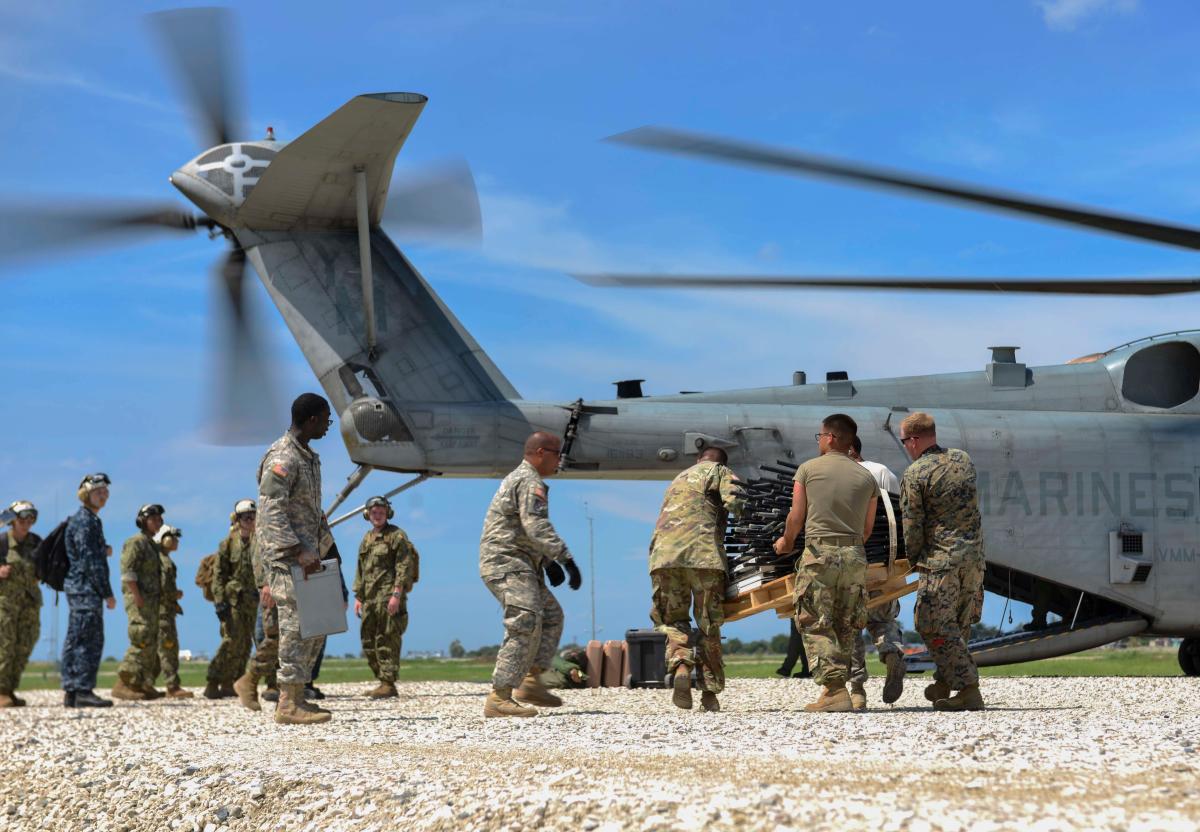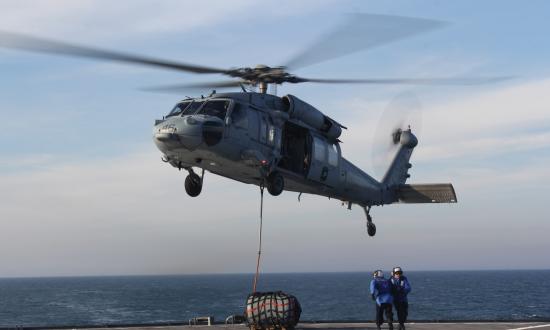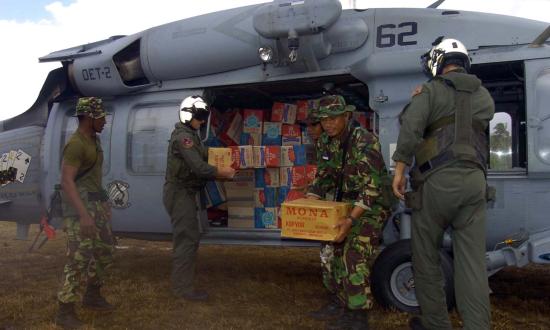The U.S. military is first and foremost a warfighting organization, but there is another area where the military in general and the Sea Services in particular can and do play an important role: humanitarian assistance and disaster relief (HA/DR). The logistical capabilities, transportation assets, capital, and durability of the military have made it a go-to for delivering and distributing aid to those in need, especially when the austerity of a post-disaster environment proves too insurmountable a hurdle for civilian aid groups.
Despite this, there are a number of issues with the military’s involvement in HA/DR operations. The military’s acquisition process is an enormous financial drain, which can deflate U.S. aid provisions when funds are directed to the Department of Defense (DoD) itself, as was the case with the nearly $700 million for post-earthquake relief in Haiti.1 In addition, military personnel often have little training specific to humanitarian operations, let alone relevant professional or academic experience that could bridge the gaps between aid workers, bureaucrats, nongovernmental organizations, and the defense apparatus ferrying goods.2 This issue can be compounded by the inherent political nature of foreign policy, including the provision of aid and the use of armed forces.3
In aggregate, these issues create challenges for military personnel, the civilians who work with them, and the population in need. As a community whose mission includes humanitarian operations, we must do better.
Humanitarian Necessity
Strategic thinking today remains inextricably linked to the relations between states, often to an unhelpful level. The net effect of this prioritization is to blind decision-makers to security problems and solutions that do not comport with traditional paradigms. The relevance for HA/DR lies primarily in the inability of states, including the United States, to fully reckon with the security challenge posed by climate change and its consequences, including mass displacement.
Since 1880, the Earth’s surface temperature has increased by 1.15° Celsius, and most of this increase has occurred in the past 40 years.4 Global sea levels have risen by approximately 20 centimeters in the past century, a situation that is accelerating with the increased ice melt at the poles.5 While previous national security strategies have noted the danger posed by climate change, too little substantive action has been taken to address how to fight future change and mitigate the effects that already have occurred. This is a security challenge that the military cannot fight with firepower.
Nor are the challenges going away. In terms of displacement alone, a widely cited projection estimates some 200 million people will be displaced by climate change by 2050 (approximately the current population of Nigeria).6 Other figures place that number as high as 1 billion, with many more affected by famine, water shortages, and other humanitarian stressors. The movement of these people, as well as the dangerous security conditions that can arise when governments respond poorly or lose legitimacy among their populations, can have further catastrophic effects. A number of scholars believe climate change, while not a singular cause (and certainly worsened by Bashar al-Assad’s economic program), played some role in the onset of the Syrian civil war.7
Sea level rise also threatens the very existence of island nations such as the Maldives and Kiribati, raising significant questions about old notions of sovereignty and state integrity.8 As the climate crisis worsens, the global community, and the U.S. military as a small subset of that community, will be left to figure out how to respond to both the causes and the effects of this new reality.
What is a HOO?
To help mitigate the disaster and humanitarian consequences of climate change, one step might be to look at the mission areas of the military’s officer community. The Navy trains surface warfare officers to drive ships, aviators to fly aircraft, and so on. It also trains officers to serve in specialized noncombat roles, including chaplains, oceanographers, and intelligence officers. There is good reason for this. The service has diverse needs and requires professionals capable of providing specialized expertise in certain mission areas. It would never expect a pilot to also be proficient in explosive ordnance disposal, yet it expects those trained to fight wars to seamlessly integrate into HA/DR missions. This reflects the extent to which the military has neglected to treat HA/DR and human security more broadly as equal with older notions of national security.
The Navy should create a dedicated community of professionals who do not fight wars, but who instead employ military assets to save lives: humanitarian operations officers (HOOs). These officers would be Navy personnel but would serve as HA/DR attachés rather than as combatants. Their mission would be to coordinate among the diverse assets at the disposal of the Department of the Navy and DoD and those who need to use them, whether a nongovernmental organization, the United Nations, or even a foreign government directing humanitarian aid. HOOs would function as conduits for other experts, such as military physicians, air crews, ship crews, and civilians, in employing their assets to further the humanitarian mission. They would bring subject-matter expertise that would greatly enhance the efficacy of combatants in an HA/DR environment.
The Pipeline
Fortunately, the Navy has an education and research infrastructure that could serve as a pipeline for establishing a HOO corps. In the initial rollout, the Navy could even lean on the direct commission program to turn current HA/DR policy and operations experts into the officers needed to set the direction for the community. These individuals could work alongside career officers versed in the Navy’s organizational structure to create a bespoke humanitarian force for the Department of the Navy.
To create subsequent generations of HOO leaders, the education programs run by Naval Service Training Command and the U.S. Naval Academy could be used to commission HOOs. These commissioning sources would remain dedicated to producing unrestricted line officers, but offering opportunities beyond those fields—similar to cryptologic warfare or supply corps—only attracts more talent. While the HOO community likely would be selective, it would provide a path for those interested in the field to bring their talents to the Navy.
From there, the new cadre of HOOs would require a community-specific pipeline akin to their combatant counterparts. The exact composition and duration of schooling could be determined by HA/DR and public health experts in conjunction with members of the Naval Education and Training Command. The pipeline likely would mirror the Navy Supply Corps School more than unrestricted line training.9 Like supply or intelligence training, it would follow a six-month to year-long program of courses such as:
• Basic humanitarian operations school
• Field-specific schools (public health, logistics, HA/DR operations in conflict, etc.)
• Follow-on department head and staff-level schools
In addition, prospective or current HOOs could benefit from educational opportunities outside their community, including advanced training at the Defense Language Institute or degree programs through the Navy or civilian institutions. Indeed, one benefit of the U.S. university system is that a new HOO corps would have access to many of the best public health programs in the country, including at schools such as Johns Hopkins, Harvard, and Columbia. It could be advantageous for the Navy to add these opportunities as both beneficial and enticing professional development opportunities akin to the MIT/Woods Hole master’s program for oceanography officers or the poli-mil master’s program for unrestricted line officers.10
HOOs in the Fleet
In an operational environment, HOOs could provide subject-matter expertise. They would have skills their ship-driving peers may have touched at some point but could never devote time or attention to. One could consider the ship’s HOO as an HA/DR equivalent to the tactical action officer (TAO), in that he or she would be responsible for employment of the ship in humanitarian relief situations. A HOO watch would not have to be set constantly, as normally would the TAO, but in an HA/DR environment, each command could call on its resident expert to help coordinate the transition from warfighter to humanitarian asset.
In the cruiser-destroyer force, for example, the HOO could work with the crew to transport material aid or conduct smaller scale evacuations or rescues. On board an amphib or in an expeditionary strike group, the HOO could serve as the command’s liaison for conducting larger scale amphibious evacuations, as occurred in Beirut during the 2006 war between Israel and Hezbollah, or overseeing larger, more logistically complex operations, such as the transportation and dispensing of food or medical aid.11
Further up the chain of command, HOOs could be called on to oversee or advise senior civilian and military leaders on conducting massive humanitarian responses, coordinating a joint or interagency response to natural disasters, mass displacement events, or the provision of aid. From the transfer of individual pallets of food to overseeing disaster response on the scale of the 2004 Indian Ocean tsunami, the HOO community would give the sea services a qualitative edge at every level of response.
Combatant units are not the only places HOOs could be embedded. The Military Sealift Command and U.S. Maritime Administration’s National Defense Reserve Fleet have large vessels, as well as specialized ships such as the USNS Mercy (T-AH-19) and Comfort (T-AH-20) hospital ships, that would be valuable assets in humanitarian response.12 As noncombatants, they can render aid without tying up the surface fleet’s warships—although time-sensitive HA/DR operations still would require immediate response from the nearest warships on station.
Because some number of these noncombatant ships could be dedicated to sustained humanitarian operations, they also would allow HOOs to remain engaged over the long term. This comports with the “resiliency model” of humanitarian response, which couples consideration of short-term emergency response with planning for longer-term consequences of a disaster.13 HOOs could remain in theater to work with their civilian counterparts and build a rapport and understanding that would allow them to better assess and address the unique challenges of each specific response.
What the HOO Program Won’t Fix
The HOO program is not a panacea for all the challenges of humanitarian response or the hazards of militarizing the provision of humanitarian aid.14 Alone, it is insufficient to address the security challenges posed by climate change and climate-related disasters. It does not address the threat of physical, sexual, or economic abuse by aid workers, peacekeepers, and military personnel in HA/DR environments or the political dimension of humanitarian aid, including how aid can be used to encroach on the sovereignty of another state or to further an outside government’s interests.15 These require a distinct response not covered by the creation of a HOO corps.
Nonetheless, the HOO program or a similar community of humanitarian professionals would provide the Sea Services a way to tackle the current difficulties of military involvement in humanitarian operations while laying the groundwork for what will be an increasingly routine part of U.S. military involvement at home and abroad in the coming years.
The military is the United States’ most capable force for humanitarian response, and as disasters grow in frequency and scale, it will be called on to render aid around the world. Meeting this challenge requires rethinking the military’s current means of conducting HA/DR operations and recognizing that those professionals tasked with employing martial force likely are not the ones best equipped to provide sustained, well-managed humanitarian assistance. In conjunction with other policies to mitigate the challenges this new security environment entails, a HOO corps may be the best bet for addressing a future where disaster, displacement, and need define the operating environment as much or more than who the enemy is.
1. Isabel MacDonald, “10 Years Ago, We Pledged to Help Haiti Rebuild. Then What Happened?” In These Times, 12 January 2020.
2. Jennifer D. P. Moroney, Stephanie Pezard, Laurel E. Miller, Jeffrey Engstrom, and Abby Doll, Lessons from Department of Defense Disaster Relief Efforts in the Asia-Pacific Region, (The RAND Corporation, 2013).
3. “The Role of the Military in Humanitarian Emergencies,” Refugee Studies Program, University of Oxford, 29-31 October1995, .
4. “Global Temperature,” NASA.
5. “Sea Level,” NASA.
6. Oli Brown, “Migration and Climate Change,” International Organization for Migration, 2008, 9.
7. Eric Holthaus, “New Study Says Climate Change Helped Spark Syrian Civil War,” Slate, 2 March 2015; and Jan Selby, “Climate Change and the Syrian Civil War, Part II: The Jazira’s Agrarian Crisis,” Geoforum 101 (May 2019): 260–74.
8. “Maldives,” UNDP Climate Change Adaptation; and Christopher Pala, “Kiribati’s President’s Plans to Raise Islands in Fight against Sea-level Rise,” The Guardian, 9 August 2020.
9. “The Supply Corps 2040 Strategic Vision Study,” U.S. Navy Supply Corps.
10. “Graduate Education,” PERS-41; and “Navy Program,” MIT-WHOI Joint Program.
11. “State Department: The July 2006 Evacuation of American Citizens from Lebanon,” Government Accountability Office, 7 June 2007.
12. “National Defense Reserve Fleet (NDRF),” U.S. Department of Transportation.
13. “Resilience and Humanitarian Action,” ODI, March 2013.
14. Jennifer Greenberg, “The ‘Strong Arm’ and the ‘Friendly Hand’: Military Humanitarianism in Post-earthquake Haiti,” Journal of Haitian Studies 19, no. 1 (Spring 2013): 95-122.
15. Skye Wheeler, “U.N. Peacekeeping has a Sexual Abuse Problem,” Human Rights Watch, 11 January 2020.






